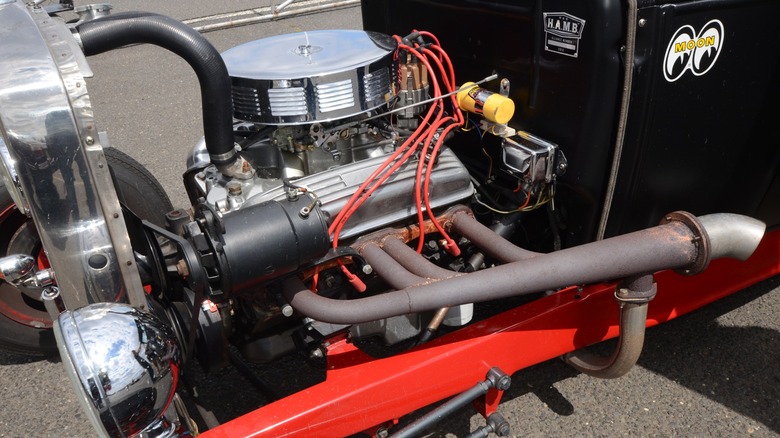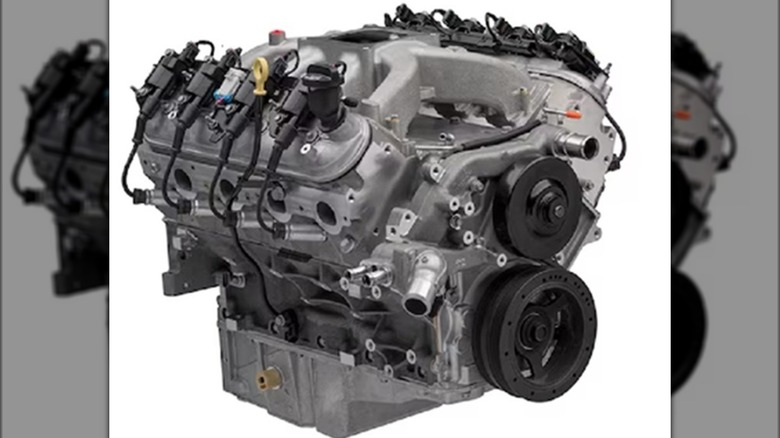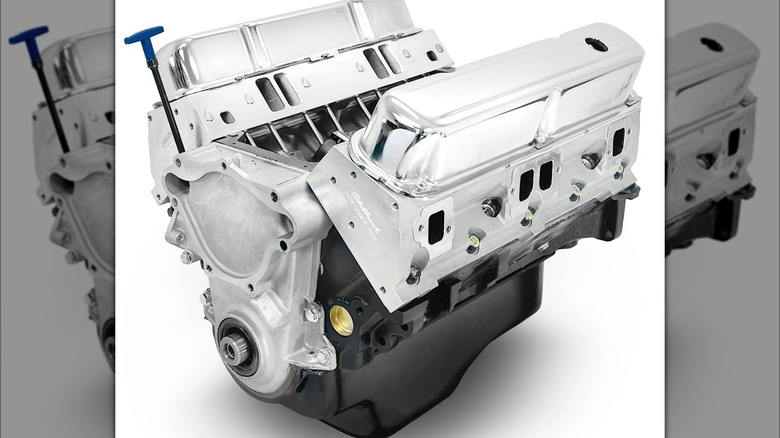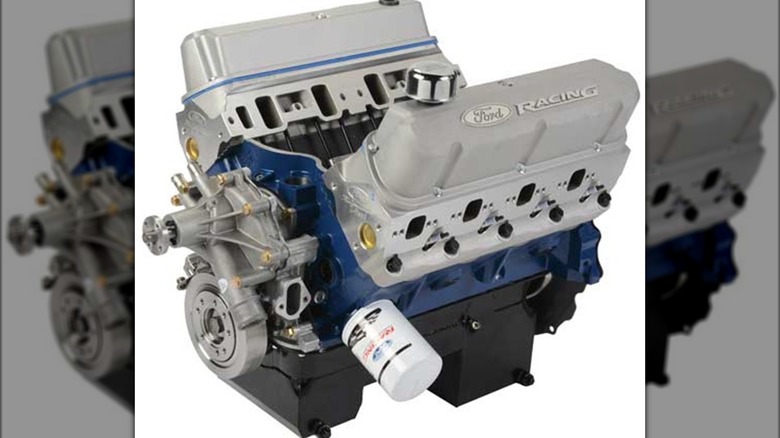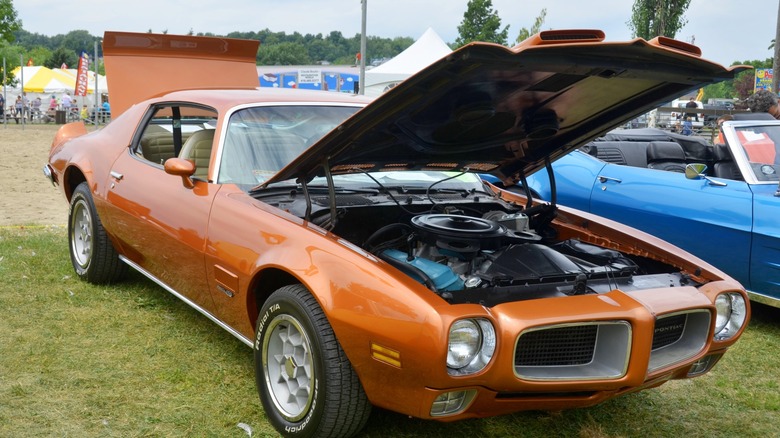4 Of The Biggest Small-Block Engines Ever Built
While there have been some iconic big-block engines over the last few decades, it's difficult to argue with the success of the small-block engine. Small-block engines not only weigh less — allowing the use of lighter, more nimble chassis and steering components in the cars they power — but they are also up to a few inches smaller than their big-block counterparts, so they fit in tighter engine bays.
Considering the small-block's advantage in size, weight, and as MotorTrend points out, lower cost, it's easy to understand why there are so many different small-blocks. Some of them even displace more cubic inches than their big-block stablemates: the old-school Chevy 400 small-block compared to the legendary big-block 396 springs to mind.
The line between small-block and big-block can be defined using the distance between the center lines of the cylinder bores. For example, the Chrysler LA-Series small-block has a cylinder bore spacing of 4.46 inches compared to the big-block Chrysler B-Series with 4.80 inches between bores. While there are no steadfast rules, engine blocks with bore spacing exceeding 4.62 inches generally fall within the big-block realm based on most automotive types, defining the Ford FE V8 as a big-block. With that in mind, let's explore four of the biggest small-block engines ever built.
The biggest Chevrolet small-block engines
While most aspects of the automotive world are in a constant state of flux, one constant is the Chevrolet small-block's 4.40-inch bore center spacing. It's been that way since the original small-block Chevys (SBC) in 1955 and remained unchanged through five generations. While no specs are available for the forthcoming Gen VI SBC, it'll likely carry on the tradition.
The biggest first-generation SBC displaced 400 cubic inches with its 4.125-inch diameter cylinders and 3.750-inch crankshaft stroke. Chevy's fourth-generation LS7 7.0L small-block, one of GM's most powerful engines, upped the ante with 427 cubic inches derived by using a longer 4.0-inch crankshaft stroke with the same 4.125-inch cylinder bore.
While Larry Gadette, Marketing Director for CFE Racing Products, refers to SBC engines with displacements over 560 cubic inches as being "clumsy," purpose-built aftermarket options using custom billet engine blocks that deviate from standard SBC bore spacing can make factory spec-imposed displace limits almost laughable. EngineLabs says that using such a block with 4.6-inch cylinder bore spacing from CFE Racing Products bored to 4.40 inches and a 4.90-inch crankshaft stroke calculates to 596 cubic inches in a package that's less than a half inch longer than the standard SBC.
The biggest Chrysler small-block engines
The biggest displacement Chrysler small-block engine, topping out at 360 cubic inches, powered many popular Mopar vehicles from its introduction in 1971 until 2002, including the Dodge Li'l Red Express pickup truck. The Chrysler LA-360 used 4.00-inch diameter cylinders and a 3.58-inch crankshaft stroke to achieve its 5.9-liter displacement. While it was replaced in 2003 by smaller displacement engines, the 5.7L Gen-III HEMI among them, a larger Chrysler small-block wouldn't come along until 2011.
After an eight-year reign, the 5.7L HEMI was surpassed by the 6.4L HEMI, which provided more displacement and power. Also called the 392 HEMI, it has larger cylinder diameters and a longer-stroke crankshaft than either the 5.7 or the LA-360; however, it maintains the LA's 4.46-inch cylinder spacing. Interestingly the Gen-III HEMI 392 actually displaces 391 cubic inches based on its 4.09-inch cylinder bores and 3.72-inch crankshaft stroke, but likely draws its name from the late-1950s Gen-I Hemi 392 that actually displaced 392.7 cubic inches with its 4.00-inch cylinders and 3.906-inch stroke.
BluePrint Engines offers a 408-cubic inch small-block Chrysler built on a "seasoned" LA-Series Magnum engine block. The LA's standard 4-inch cylinder bore is taken to 4.04 inches and the longer 4.00-inch crankshaft stroke provides the increase in displacement. Oddly enough, their advertised bore and stroke dimensions calculate to 410.2 cubic inches, most likely due to mid-formula rounding discrepancies.
What's the biggest Ford small-block?
Ford small-blocks, with displacements like 289 and 302 cubic inches, are among the most iconic engines of the muscle car era; however, they're not the biggest. The 351 is another popular Ford small-block offered as Cleveland, Windsor, and M variations. While Cleveland and Windsor denote the locations of their respective manufacturing plants, the M designation is less clear with Modified, Michigan, and Midland among the most popular options.
The Ford 400 (actually 402 cubic inches) shared the same 4.38-inch cylinder spacing as the other engines and was the automaker's largest production small-block featuring 4.00-inch diameter cylinders and a 4.00-inch crankshaft stroke. However, Ford offers a 460-cubic inch small-block as a Boss crate engine.
The Ford 460 crate engine has 4.15-inch diameter cylinders, a 4.25-inch crankshaft stroke, and a host of high-performance parts. Despite its large displacement, the engine is based on Ford 351 small-block architecture, although its listed deck height, connecting rod length, and higher exhaust ports don't match with other 351 Ford specs.
Other GM small-block V8s with big displacements
Skirting under the line between big- and small-blocks like they were playing limbo are a pair of old-school 455-cubic inch engines from General Motors. In its early years, GM allowed the automakers under its wing to explore the production of engine options to fit their needs. The 455-cubic inch engines from Pontiac and Oldsmobile are perfect examples.
The Pontiac 455 used an engine block with 4.1525-inch cylinder bores on 4.62-inch centers and a 4.21-inch stroke crankshaft to displace 456.1 cubic inches. Oldsmobile on the other hand used a smaller cylinder bore with more crankshaft stroke (4.126-inch bore and 4.25-inch stroke) to achieve its 454.6 cubic inches.
While these engines exist in a shadow area between big- and small-blocks, we'll have to disqualify the Oldsmobile 455. Although all Olds V8 engines, other than the rare 215 from the early 1960s, shared the same 4.625-inch cylinder bore spacing, the company used two different-sized engine blocks, one taller and wider than the other. Of course, the Olds 455 is based on the larger one.
Some may wonder, does the Pontiac 455 belong in the big-block group as well due to its 4.1525-inch cylinder bores and large displacement? While that question has merit, it's worth noting that all Pontiac V8s share the same size engine block foregoing the distinction between big and small.
